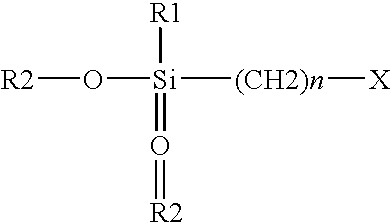[0021]A further
advantage of the present invention is the improved
clarity, greater transparency, increased
light transmission and reduced
haze or
scattered light that results from the use of a reactive tintability
enhancer that coreacts and polymerizes with the other monomers of the coating. Improvement in these properties is highly desirable for ophthalmic lenses.
[0022]The tintable coating solutions of prior art that use nonreactive tintability enhancers tend to look clear before they are cured because the tintability
enhancer is dissolved in the coating solution. However, those tintability enhancers can or do become insoluble or at least less soluble in the coating. This can cause the enhancers to separate out from the bulk of the coating as the
solvent evaporates and especially as the
polymer of the coating is cured to the highly crosslinked state of a thermoset
polymer that is needed for mar resistance to prevent scratches from occurring. The undissolved tintability enhancers can precipitate out or separate from the bulk into small domains (e.g., dispersed phases, dispersions or emulsions) that scatter light to create a
haze and reduce transparency. These domains of very fine particles or regions of trapped liquid can be seen under a
microscope. Due to enhanced contrast, the
haze is even more noticeable or visually apparent after the lens has been tinted.
[0023]Coatings based on the present invention exhibit much greater
clarity, greater transparency, greater
light transmission, and lower haze values than coatings of prior art. This is because the tintability enhancers of the present invention can not separate out from the crosslinked polymer of the coating since they have reacted with and permanently become an integral part of the crosslinked polymer that comprises the coating itself.
[0024]The effects of
light dispersion in coatings and
layers may be readily measured with existing commercial equipment that compares the intensity and / or
wavelength distribution of light that is reflected or transmitted through
layers, one a standard or known value of transmission and / or reflectance and the other being the layer or coating to be measured for light dispersing effect. Emulsions or dispersions or suspensions of material having different indices of
refraction (which dispersed, suspended or emulsified enhancers would be likely to have) alter the transmission and / or reflectance of light and change its intensity and / or
wavelength composition and organization by
absorbance,
refraction, or light dispersing effects, such as edge defects.
[0025]A
system or method for measuring such differences in reflected or transmitted
radiation (e.g., IR, UV or
visible radiations) might be constructed and perform as a set of light detectors that may be any
light detection system that can quantify the amount of incident
radiation received by the
detector. It is possible to use
semiconductor, piezoelectric, electro-optic,
wide area detectors,
fiber optic or other detection systems at the choice of the designer. A preferred
system would use a Model 371
Optical Power Meter (available from United
Detector Technology, Baltimore, Md.). The
laser light used was a LaserMax, Inc., Model LAS 200-650-5 (available from LaserMax, Inc. Rochester, N.Y.). One example is a
single chip channel GaAs electro-optic
waveguide device. The device comprises an input
waveguide, into which the beam is input, and a 1 to 16 way
multimode interference splitter for splitting the input beam into n different outputs. For example, this may be a
multimode interference splitter as described in U.S. Pat. No. 5,410,625. The device also comprises 16 electro-optic waveguides for optical
phase control, each electro-optic
waveguide may have an
electrode for applying an
electric field across each waveguide. The system my be self-contained, with transparencies inserted into an apparatus, the apparatus closed against incident
radiation and light, measurements taken and recorded and evaluated, and the system opened for removal of that system. Blockage of ambient light is desirable or essential for precise measurements. The ratios of (λT) / λS) (that is where (λS) is the amount of light incident on the transmitting or reflecting surface and (λT) is the amount of light reflected or transmitted) or (λS) / (λT) are highly meaningful and represent clear indicators of the suitability of transparencies, even before they are projected onto a screen. In different uses, different ratios may be acceptable, but the user can determine what values are acceptable or not, or a program associated with a processor receiving the data can evaluate the suitability of the ratio for any use or specific uses. For example, where a small decrease in
light transmission is tolerable, a low (λS) / λT) ratio (e.g., 1.0-1.2; or 1.0-1.1) may be acceptable. On the other hand, where there is a very large tolerance for decrease in transmission or eflectance, a higher (λS) / λT) ratio (e.g., 1.15-2.0 or greater) may be acceptable. It is preferred that (λS) / (λT) have a value between 1.0 and 1.15 or between 1.0 and 1.10 or between 1.0 and 1.05. These values may also be referred to as percentage decreases in transmission of light (or reflectance of light) by comparing the (λS) to the / λT) as (λT / λS)) / (λS) being between 95-100%, between 97-100%, between 98-100%, or between 99-100% relative transmission, this ratio at a
wavelength of maximum absorption of the coating (e.g., with any photochromic dye at approximately full
optical density or with the photochromic dye at near minimum
optical density) being herein defined as relative transmission.
[0026]Optionally, various acrylates may be added, which may be a combination of di-, tri-,
tetra-, penta- or
hexa-acrylates, as determined by the desired properties, including viscosity, tintability, mar resistance, and adhesion. Variations in the ratio of trialkoxysilane to acrylated monomers can be made to develop coatings that meet the specific requirements of customers, such as better adhesion, increased mar resistance, or faster tint absorption.
 Login to View More
Login to View More 


